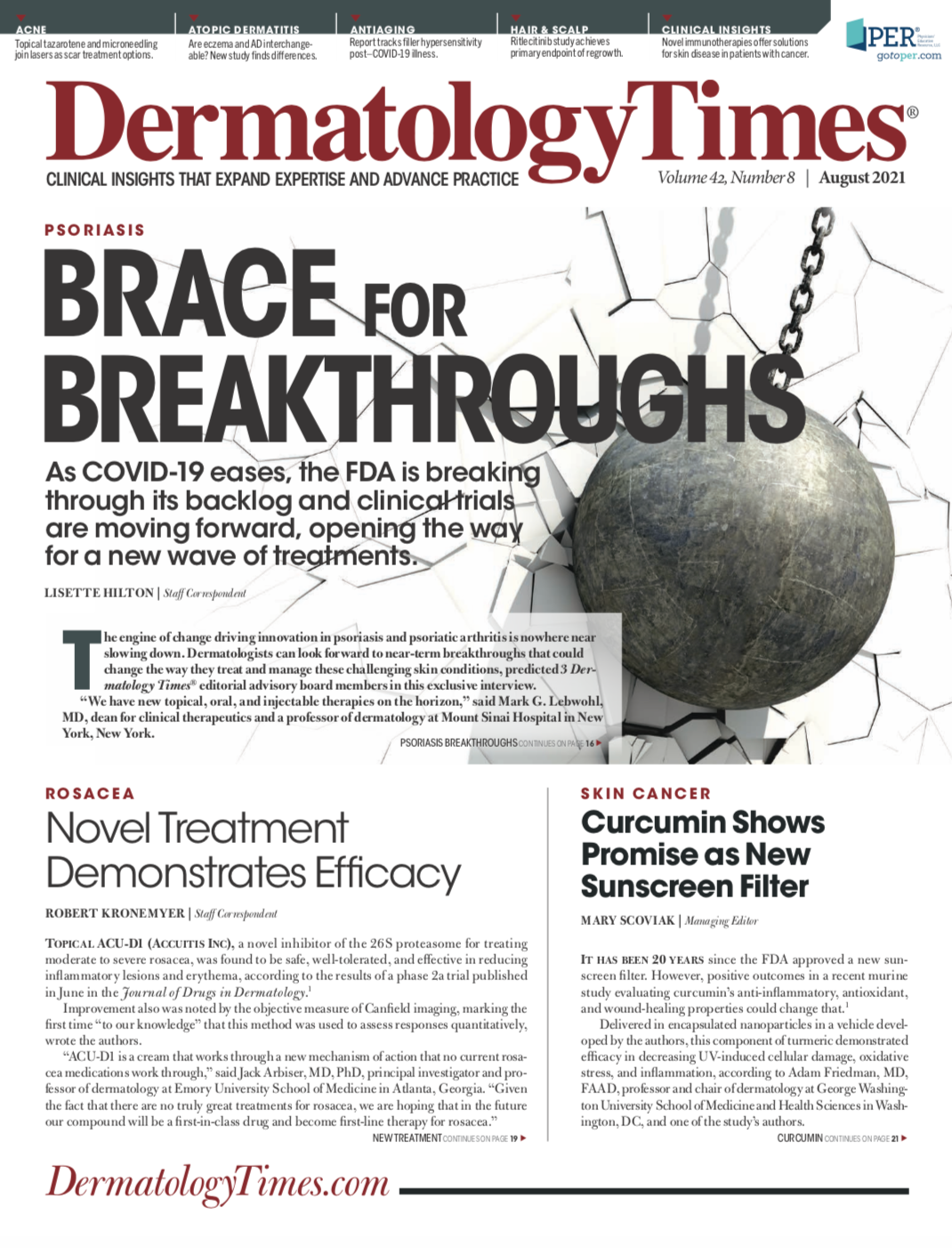- Case-Based Roundtable
- General Dermatology
- Eczema
- Chronic Hand Eczema
- Alopecia
- Aesthetics
- Vitiligo
- COVID-19
- Actinic Keratosis
- Precision Medicine and Biologics
- Rare Disease
- Wound Care
- Rosacea
- Psoriasis
- Psoriatic Arthritis
- Atopic Dermatitis
- Melasma
- NP and PA
- Skin Cancer
- Hidradenitis Suppurativa
- Drug Watch
- Pigmentary Disorders
- Acne
- Pediatric Dermatology
- Practice Management
- Prurigo Nodularis
- Buy-and-Bill
Publication
Article
Dermatology Times
Filler Hypersensitivity Post COVID-19 Illness
Author(s):
Do COVID-19 antigens cause hypersensitivity to dermal fillers?
The Journal of Cosmetic Dermatology recently published a case report examining hypersensitivity reactions to hyaluronic acid (HA) dermal filler after COVID-19 infection.1
In 2019, there was a 15.7% increase in the number of HA filler treatments performed, resulting in over 4 million treatments worldwide compared with the preceding year. HA filler is found natively in the mammalian tissue and is often considered to not interact or initiate a response when introduced to biological tissue.
“Type 1 hypersensitivity reactions are immunoglobulin E (IgE)-mediated, occur rapidly within minutes or hours, and can result in anaphylaxis or angioedema,” according to the case study authors. “Delayed-type hypersensitivity to HA filler are rare reactions, occurring anywhere between 24 hours to weeks or months after placement. Presenting as a firm erythematous swelling that is often tender to touch, they are caused by a T-lymphocyte mediated response.”
The incidence rate (IR) of a delayed-type hypersensitivity reaction is cited as between 0.3% and 4.25%.1
The exact cause of delayed-onset reactions is not yet understood. Factors that may contribute to these incidents include infections, filler properties, trauma, and injection technique, with multiple treatment episodes and links to influenza‐like illness.
Study authors examined the June 2020 case of a 22-year-old female with a raspberry sensitivity who underwent a nonsurgical rhinoplasty procedure using HA dermal filler (Perfectha Subskin; Sinclair Pharma) to adjust the view of her dorsal hump. At the time of the procedure, no adverse events (AEs) were reported.
Filler was injected using a 30G x 8 mm 0.3 mL BD Microfine needle to reduce injection trauma and improve precision. Filler placement was made to the area of the nasal radix with the needle perpendicular to the bone, depositing 0.5 mL in 0.1 mL increments that were 5 mm apart, in line with documented techniques. Further placement was made at the nasal tip, depositing 0.3 mL in 0.1 mL. Injection volumes totaled 0.8 mL. The patient underwent the same procedure again in July 2020 with no reported AEs.
In October 2020, the patient received a COVID-19 diagnosis and had cold-like symptoms. Three weeks after diagnosis, in November, she exhibited the following AEs: edema, induration, erythema, mild associated tenderness, and a tight feeling in the area around the radix.
After coming back to the practice 1 day after her symptoms began, she explained that there had not been any trauma or acute skin infection to the treatment site or surrounding areas. She also noted that she had not had any dental work done, started any medication, or had any additional medical procedures between July and November 2020.
The swelling and erythema subsided while the patient was in the clinician’s office and the radix was no longer tender, or as tight. The patient refused oral steroids and instead chose to have her symptoms monitored. By day 6, all symptoms had resolved without medical intervention. However, the dorsal hump that had originally been addressed with nonsurgical rhinoplasty was again visible. After the resolution, the patient declined any further investigations into the cause, including a biopsy or antibody testing to ascertain an immunologic status after COVID-19 contraction. An official diagnosis of a delayed‐type hypersensitivity to HA dermal filler resulting from COVID-19 infection was then made.
The exact cause of the delayed‐type hypersensitivity reaction in this case remains unclear. The authors have deemed it likely to be an immunologic reaction between COVID-19, trauma, and HA filler.
Findings from another case published in the journal concerned a 32-year-old patient who had received HA filler in February 2020.2
The patient had undergone filler injections in multiple sites on her face. She had been receiving fillers regularly for 6 years before any AEs were reported. Months after receiving her latest round of filler treatments and experiencing no AEs, she had sudden swelling of the periocular area in December 2020.
Until this point, the patient had reported no AEs and confirmed that no additional procedures had been done in the 10-month period since her facial injections. She received a COVID-19 diagnosis in November 2020, was antigen positive, and subsequently became antibody positive as well. The swelling subsided a few days after she had used an oral anti-inflammatory.
In a phase 3 trial examining COVID-19 vaccine efficacy, face and lip swelling was reported in 3 study patients after they received the Moderna vaccine.3 Two of the 3 patients had a history of previous dermal filler treatment. The first patient had received cheek filler 6 months prior to the vaccination whereas the second patient underwent lip augmentation using filler 2 days after COVID-19 vaccination.
All patients who receive HA filler have a risk of hypersensitivity and most will encounter flu-like illnesses at some point. This risk may currently be higher as COVID-19 infection rates increase. Further investigation is needed to establish the cause and effect of hypersensitivity reactions, including those linked to COVID-19.
References:
1. Shome D, Doshi K, Vadera S, Kapoor R. Delayed hypersensitivity reaction to hyaluronic acid dermal filler post-COVID-19 viral infection. J Cosmet Dermatol. 2021;20(5):1549-1550. doi:10.1111/jocd.14046
2. Rowland‐Warmann MJ. Hypersensitivity reaction to hyaluronic acid dermal filler following novel coronavirus infection – a case report. J Cosmet Dermatol. 2021;20(5):1557-1562. doi:10.1111/jocd.14074
3. Buntz B. Moderna COVID‐19 vaccine might cause facial swelling for people with dermal fillers. Drug Discovery & Development. December 17, 2020. Accessed June 1, 2021. https://www.drugdiscoverytrends.com/moderna-covid-19-vaccine-might-cause-facial-swelling-for-people-with-dermal-fillers/






